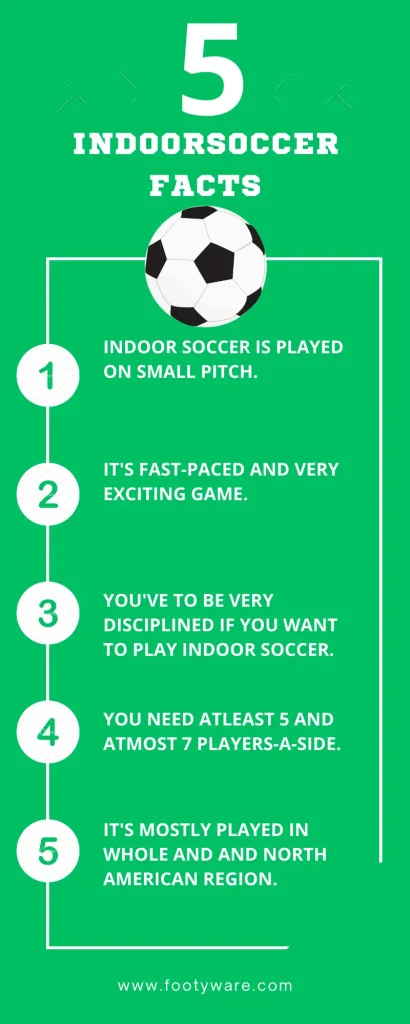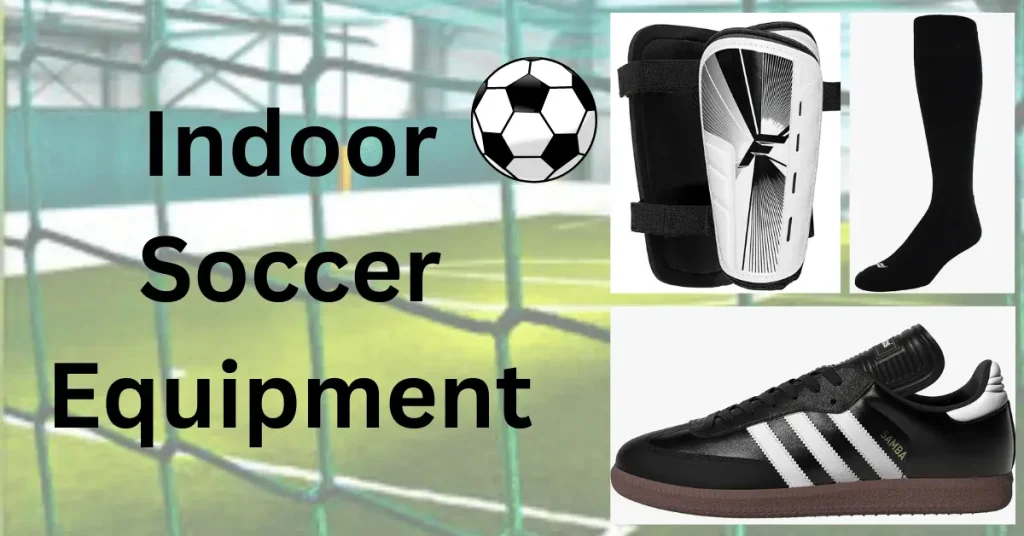What is Indoor Soccer Name? It’s Called Futsal

Soccer’s not just for outdoor stadiums anymore! Under the bright lights of indoor arenas, a fast-paced, skill-filled version of the beautiful game thrives – but what do you call this electrifying dance between players and polished courts?
Hold onto your cleats, because it gets a bit tricky. Indoor soccer has a whole bag of nicknames, each capturing a different flavor of the game. Here’s your decoder ring:
Futsal
The official champ, FIFA-approved and played on a smaller court with sidelines instead of walls. Think lightning-fast footwork, pinpoint passes, and a low-bounce ball that sticks close to the ground. Imagine Messi weaving magic on a hardwood stage – that’s futsal!
Arena Soccer
This name shines the spotlight on the indoor arena, where weather worries vanish and the game roars year-round. Think of high-flying action, powerful kicks, and padded walls that keep the ball in play. Picture Ronaldo unleashing a thunderous shot off the boards – that’s arena soccer!
Indoor Football
A simple name, popular in North America where the game first took root. Think five-a-side matches, friendly kickabouts, and a vibrant community of players of all ages and skill levels. Picture your local rec center buzzing with friendly competition – that’s indoor football!
Small-Sided Soccer
This name emphasizes the smaller playing area compared to outdoor soccer. Think of quick thinking, tight spaces, and a focus on technical skills over long sprints. Picture a futsal court buzzing with a ballet of passes and deft touches – that’s small-sided soccer!
But remember, names are just part of the fun! Whether you call it futsal, arena soccer, or indoor football, one thing’s clear: this game is all about passion, skill, and community. So, lace up your shoes, gather your team, and hit the court! It’s time to unleash your inner Messi and experience the electrifying world of indoor soccer, whatever name you choose!
Origins and History of Indoor Soccer
Soccer was played from the early 18th century but indoor soccer surfaced in the 1930s and players also started playing inside with a limited number of players available especially in the winter season due to harsh weather When outdoor soccer wasn’t possible indoor soccer came into existence.
Indoor soccer was later formalized in 1971 when the North American Soccer League organized some tournaments from then tournaments were organized in a continuous way and indoor soccer tournaments were formally continued.
After that business owners like Earl Foreman and Ed Tepper started taking interest and you know when the corporate sector was involved they could easily change the perspective of the game then Major Indoor Soccer League was formed to conduct indoor soccer in a league format like outdoor soccer.
First, there were only 6 franchises and then it expanded and still doing the best for indoor soccer and conducting the best tournaments and leagues on different formats for both genders while the rules and regulations started evolving with time and now some notable indoor soccer rules are already covered.
Facts about Indoor Soccer

Indoor soccer is now played all around North America while in the world it’s being played under the name of futsal with some changes in the rules but they both are almost the same and can be used alternatively for each other.
MASL expanded when digitized now you can’t only watch live in the arena but in your home on your TV screens which made a huge impact and gave the required popularity to the game its first deal was with USA Network which made its expansion easy.
After the digital success, there was a separate fanbase and the public started making their idols of indoor soccer and started following them more closely. It’s also the best opportunity for emerging players to come forward and make their name for themselves and make the public entertain.
Now other brands are also working to make more platforms for indoor soccer leagues and tournaments to expand the game. Now the sport is attracting some of the top talents from around the world and thousands of fans started watching games in the arena, especially in winter.
Indoor Soccer vs. Traditional Soccer
| Indoor Soccer | Traditional Soccer |
|---|---|
| It’s a fast-paced game. | Traditional/Standard soccer fields are large. |
| Flexible in terms of players available(5,6,7 players a team according to the availability) | Not flexible only 11-a-side only. |
| No throw-ins allowed. | No throw-ins are allowed. |
| Indoor soccer fields are more minor. | You can also play if you aren’t that fast. |
| It’s played on flat, shiny, and wooden surfaces. | It’s played on soft, firm, or grassy ground. |
| Indoor soccer needs less time. | Outdoor soccer needs more time. |
| Flat outsole shoes are used in indoor soccer. | Cleats are being used in traditional soccer having plastic or steel studs. |
| No offside rule applies here. | Offside rules apply in soccer. |
These are some of the major differences between indoor soccer and traditional soccer. There are more too but they’re specific and for rules of indoor soccer you can also read about them.
Indoor Soccer: An Exciting Game
Indoor soccer is a fast-paced game, making it more exciting to watch and play. The small field and less space bring more physical contact in play on an indoor soccer court which makes it more interesting and thrilling.
Indoor soccer brings quick transitions, close ball control, and skillful dribbling which is joyful to watch and brings more crowd to watch and expands the game. Indoor soccer needs agility and quick decision-making to play on a competitive level.
Modification in Rules for Indoor Soccer
Indoor soccer is modifying day by day because it’s still s new game. There was no offside in outdoor soccer for a very long time and then a back pass to own keeper and he would grab the ball was also used to waste time so these flaws were being highlighted and now mitigated with the help of rules.
The same goes for indoor soccer and it needs to be modified like kick-ins instead of throw-ins to keep the flow of the game on the ground. Walls are used intelligently to the advantage of the player having a ball in possession like the ball rebounds. This is to keep the intensity of the game high and to keep it flowing.
Indoor Soccer Equipment to be Used
The following equipment is used in indoor soccer
- Indoor soccer shoes mostly have flat outsole.
- Shin guards.
- Long socks.
- Small ball size.

Indoor Soccer Leagues and Tournaments
Indoor soccer is very popular worldwide because various tournaments and leagues are being arranged by leading organizers like the Major Arena Soccer League (MASL) and the National Indoor Soccer League (NISL).
Other platforms for players to showcase their skills and compete with various players were made possible by these organization committees. They’ve played a vital role in expanding this game worldwide.
Further, it became more widely spread when proper media coverage was given to indoor soccer and is now widely followed on social media too. Due to this, there’s a constant rise in the fanbase of indoor soccer. People are turning out in masses to watch this game and recognize the level of skill of these extraordinary players.
Benefits of Playing Indoor Soccer
There are various benefits of playing indoor soccer for all age groups and players with different skill levels:
- Increase awareness of the pitch in a compact environment.
- Improves the first touch on the ball.
- Fast-paced nature enhances skill and agility which as a result improves decision-making ability.
- It requires tough fitness due to intense activity which helps in reducing cardiovascular diseases.
- Indoor soccer promotes teamwork and communication among players which makes a team work like one unit.
Strategies for Indoor Soccer to be Used
Indoor soccer needs proper strategic planning before starting a competitive game.
- You’ve to be perfect in one-touch passes.
- On a smaller pitch, you have to make some swift movements, and quick reaction passes.
- Be very responsive on the pitch and read the gameplay accordingly.
- You’ve to be very creative on and off the ball to make runs that’re difficult to track your opponents.
- Never lose the shape of your team and always concentrate on your manager’s advice.
- Be ready to exploit your opponents in a creative play.
- Pressing and counter-attacking are the key so act according to the needs of the game.
- Adapt to quickly changing situations and gel with your team like one unit.
Conclusion of What is Indoor Soccer Called?
The beautiful game takes a vibrant turn indoors!
Whether you call it futsal, a FIFA-endorsed ballet of footwork on a smaller court, or arena soccer, where thunderous volleys echo off padded walls, indoor soccer ignites a global passion that transcends mere names.
This electrifying dance of skill and speed unfolds in iconic arenas like the Baltimore Arena, where Falcao moves weave magic on polished hardwood. But the magic extends far beyond the pros. MASL (Major Arena Soccer League) ignites the competitive spirit, while local rec centers buzz with the friendly rivalry of indoor football matches.
Indoor soccer isn’t just for seasoned veterans. It’s a haven for youngsters honing their skills, dreaming of emulating their heroes like Ronaldinho. It’s a fitness playground for adults, building camaraderie and shedding pounds with every sprint and deft touch.
The smaller playing area demands tactical brilliance, while the fast pace keeps hearts racing and endorphins surging. And unlike fickle weather, indoor arenas guarantee year-round action, letting you unleash your futsal fury whenever the urge strikes.
So, whether you call it futsal, arena soccer, small-sided magic, or simply the indoor game, remember, this isn’t just a sport – it’s a global community. It’s the thrill of a pinpoint pass finding its target, the joyous roar of a winning goal, and the bonds forged in the heat of competition.
So, grab your trusty Nike Mercurial or Adidas Tango Sala shoes, lace up, and join the futsal frenzy!
Hit the court, immerse yourself in the rhythm of the game, and discover a world of passion, skill, and community waiting to captivate you. Remember, the beautiful game thrives not just on names, but on the shared language of footwork, finesse, and futsal fury!

